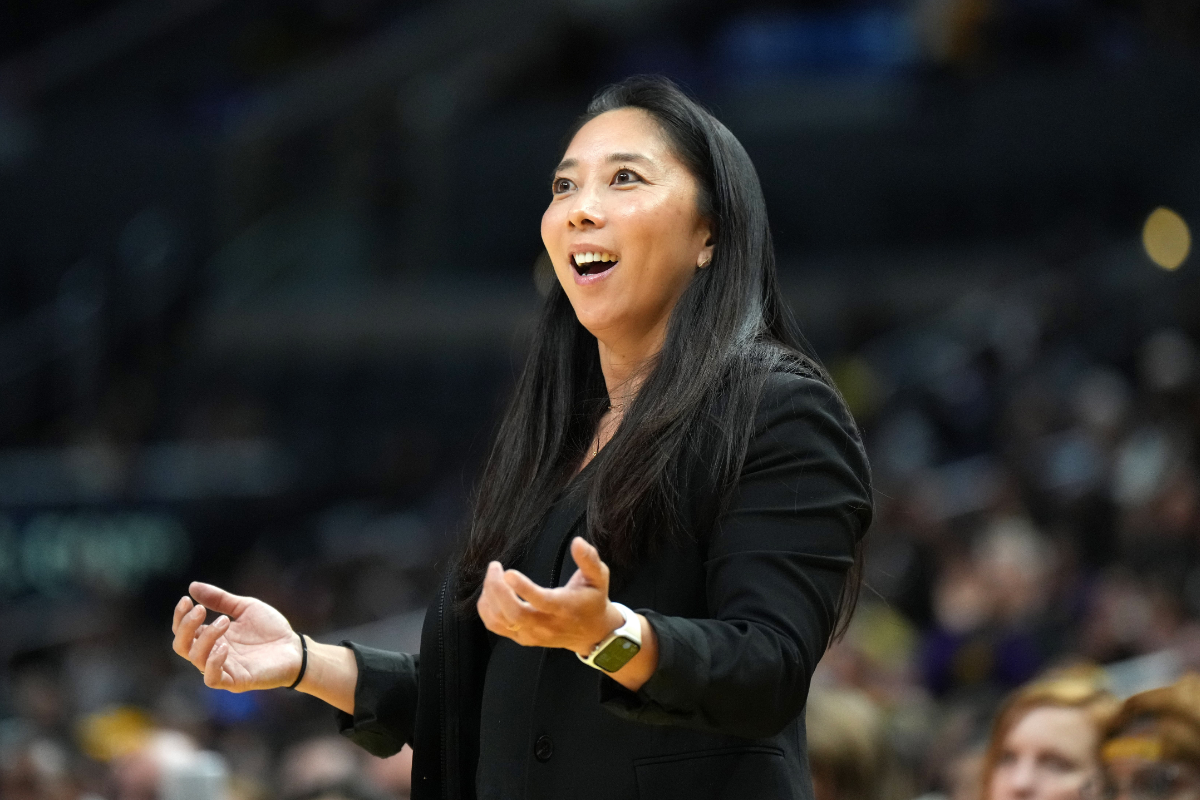
USA Today via Reuters
Las Vegas Aces first assistant coach Natalie Nakase reacts during the first half Las Vegas Aces at Crypto.com Arena. Mandatory Credit: Kirby Lee-USA TODAY Sports

USA Today via Reuters
Las Vegas Aces first assistant coach Natalie Nakase reacts during the first half Las Vegas Aces at Crypto.com Arena. Mandatory Credit: Kirby Lee-USA TODAY Sports
While the 2025 WNBA season is still way off, it’s already generating a lot of buzz. It is not just the potential debut of Paige Bueckers, another rising star, but also for the league’s expansion with the addition of the Golden State Valkyries. Incredibly, the franchise has already made waves with record-breaking ticket sales, selling out arenas before even stepping onto the court.
Watch What’s Trending Now!
The Golden State Valkyries are nearly ready to make their mark in the WNBA, having already checked off many key boxes. They’ve hired a general manager, a director of basketball operations, a president, and even secured a head coach in Natalie Nakase. The team also has an arena ready to host fans. But there’s one crucial piece still missing: the players. While the stage is set for their roster-building in the expansion draft on December 6th, the Valkyries may face some challenges.
ADVERTISEMENT
The Expansion draft dilemma: Navigating the “Core” rule and roster challenges
Navigating the expansion draft for the Golden State Valkyries won’t be as straightforward as they may have hoped, thanks to a mix of WNBA and CBA rules. Each of the 12 existing teams can protect up to six players, limiting the Valkyries to selecting only one player from each team — one unprotected, unrestricted free agent.
The best fans in the game – period.
20,000 season ticket deposits and another day closer to tip-off at Chase Center. Let’s keep making history together. #JointheAscent pic.twitter.com/vMOlRc6qk3
— Golden State Valkyries (@wnbagoldenstate) November 12, 2024
This rule presents a loophole—some teams, due to strict regulations around “core” players, may technically have more than six players protected. This could be a challenging factor for the Valkyries as they look to build their roster for the 2025 season. In the WNBA, the “core” designation allows teams to label one unrestricted free agent as essential to their success, identity, and brand. This move revokes their unrestricted status, giving the team exclusive rights to negotiate a new contract with the player.
ADVERTISEMENT
When a player is designated as a core athlete, they receive a one-year supermax contract, as per CBA, but can only be given this designation twice. There are few teams with multiple players who’ve been designated core players twice, a designation that complicates the roster-building process. Here’s the catch: the rules prohibit selecting a player who’s been named core twice—unless that player has signed a new contract after their second core deal. This adds an extra layer of complexity for the Valkyries as they navigate their options.
Top Stories
Andy Reid Announces Decision on Leaving Chiefs on Monday, Days After Playoff Elimination

Jon Rahm Receives Fresh Warning After Brooks Koepka Quit LIV Golf Abruptly: ‘In the Worst Spot’

Sources: Raiders to Fire Pete Carroll After Chiefs Game; Tom Brady Holds Say on John Spytek’s Future

LeBron James Stats on His Birthday: How NBA Icon Has Performed on December 30th

“Nothing Lasts Forever”: Israel Adesanya Opens Up on Overcoming Suicidal Thoughts

Denny Hamlin Faces Unthinkable Loss After Tragic House Fire on Parent’s 52nd Anniversary Night

ADVERTISEMENT
The impact of the “Core” rule: Limited roster options and strategic planning for the Valkyries
The Valkyries’ expansion draft options are limited by some key players they can’t select due to the core rule. Jonquel Jones, who was designated core twice by the Phoenix Sun before being traded to the New York Liberty, signed a new two-year deal in 2024, meaning the Liberty must protect her.
Breanna Stewart, designated core only once, also has to be protected by the Liberty, or the Valkyries could claim her and make her a core player. Nneka Ogwumike, an unrestricted free agent who’s been core twice, is ineligible for the draft, giving the Seattle Storm an extra protected player, bringing the total to 7.

Getty
NEW YORK, NEW YORK – SEPTEMBER 19: Breanna Stewart #30 and Jonquel Jones #35 of the New York Liberty celebrate a block against the Washington Mystics during Game Two of Round One of the 2023 Playoffs at the Barclays Center on September 19, 2023 in the Brooklyn borough of New York City. NOTE TO USER: User expressly acknowledges and agrees that, by downloading and or using this photograph, User is consenting to the terms and conditions of the Getty Images License Agreement. The Liberty defeated the Mystics 90-85 in overtime. (Photo by Bruce Bennett/Getty Images)
This reduces the Valkyries’ roster options even further, especially with the uncertainty caused by the upcoming CBA negotiations. Most players are signing one-year deals, likely to benefit from the new CBA in 2026, making roster-building even more challenging for the expansion team.
ADVERTISEMENT
The Valkyries find themselves in a tough spot, and it’s not because of anything they’ve done wrong. If the Golden State front office is looking to build a long-term team, this offseason likely isn’t the time for it—aside from possibly focusing on the college draft. The reality is, right now, the Valkyries’ roster is essentially a blank slate. On paper, they might end up with many one-and-done contracts this year, making it more strategic to focus on planning for 2026 instead. Now, let’s try to take a closer look at the “core” designation rule of WNBA.
ADVERTISEMENT
The Core Rule: Balancing team stability and player autonomy in the WNBA
The core rule, similar to restricted free agency, is designed to help franchises retain their top players. It primarily protects smaller market teams from losing their star talent to bigger markets or super teams. In many cases, a ‘cored’ star signs a trade deal to move to a new team, providing compensation to the team losing her. In short, it ensures teams have control over their most valuable assets, reducing the risk of financial instability.
This rule, while providing teams with stability and control, raises some important concerns, especially when it comes to player autonomy. While the system ensures teams can keep their star players, it limits a free agent’s ability to choose not just their team, but also the city they’ll live in for part of the year. This brings up a significant ethical question: players, like anyone, should have the right to decide where they play and settle.
Moreover, while the rule is intended to protect the WNBA, may actually hinder the league’s growth by limiting player movement. Unlike the NBA, where free agency stirs excitement and media frenzy, the WNBA sees far less off-season activity, especially among star players. While the core rule helps maintain balance and competition, it also prevents the league from experiencing the same level of buzz and fan engagement that comes with a more dynamic free agency.
ADVERTISEMENT
As the Valkyries prepare for their inaugural season, navigating the challenges of the expansion draft and the core rule will be crucial. Their future success may depend on how they balance short-term limitations with long-term vision.
ADVERTISEMENT
ADVERTISEMENT
ADVERTISEMENT

